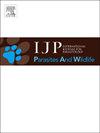Eco-epidemiology of gastrointestinal parasitic infections in captive chimpanzees in Gabon
IF 2
3区 医学
Q3 ECOLOGY
International Journal for Parasitology-Parasites and Wildlife
Pub Date : 2025-06-10
DOI:10.1016/j.ijppaw.2025.101101
引用次数: 0
Abstract
This study investigates the influence of abiotic variables (precipitation, soil surface temperature, and soil water content) and intrinsic factors (sex, age class, and social status) on the occurrence of gastrointestinal parasitic infections in two populations of chimpanzees (Pan troglodytes) in Gabon: one in captivity at the Primatology Center of CIRMF (n = 41) and the other in semi-captivity at Lékédi Park (n = 46). A total of 87 fecal samples were analyzed using flotation and sedimentation techniques. Fourteen gastrointestinal parasite taxa were identified, including two novel findings in chimpanzees: Fasciola hepatica and Toxocara sp. The overall prevalence was 85.4 % at the Primatology Center and 95.7 % at Lékédi Park. Binary logistic regression models revealed significant associations between intrinsic traits and parasite occurrence in captive individuals. Juveniles were at higher risk of Balantioides coli infection compared to adults (OR = 7.24; 90 % CI: 2.15–24.3; p = 0.047), while subordinate individuals were less likely to be infected than dominants (OR = 0.08; 90 % CI: 0.02–0.165; p = 0.007). Males were significantly more likely to be infected with strongylid nematodes (Strongylida fam. gen.) than females (OR = 6.58; 90 % CI: 1.90–22.7; p = 0.023). No significant associations were found between intrinsic factors and parasite occurrence in semi-captive individuals. Precipitation was significantly associated with increased infection risks in semi-captive chimpanzees, particularly for Balantioides coli, Entamoeba sp., Mammomonogamus sp., Strongyloides sp., and Trichuris sp. Conversely, in captive chimpanzees, precipitation was negatively associated with Entamoeba sp. and Strongylida fam. gen. Soil surface temperature was inversely correlated with the presence of Balantioides coli, Entamoeba sp., and Mammomonogamus sp. in the semi-captive group. No significant associations were detected between soil water content and parasite occurrence. A Spearman rank correlation analysis revealed a strong positive, though non-significant, relationship between parasite prevalence in soil samples and in captive chimpanzees (ρ = 0.82; p = 0.089).

加蓬圈养黑猩猩胃肠道寄生虫感染的生态流行病学研究
本研究调查了非生物变量(降水、土壤表面温度和土壤含水量)和内在因素(性别、年龄类别和社会地位)对加蓬两种黑猩猩(Pan troglodytes)胃肠道寄生虫感染发生的影响:一种在CIRMF灵长类学中心圈养(n = 41),另一种在lsamksamdi公园半圈养(n = 46)。采用浮选沉淀法对87份粪便样本进行了分析。共鉴定出14个胃肠道寄生虫类群,其中在黑猩猩中有2个新发现:肝片吸虫和弓形虫。灵长类学中心的总患病率为85.4%,lsamksamdi公园的总患病率为95.7%。二元logistic回归模型显示,圈养个体的内在性状与寄生虫发生之间存在显著相关性。与成人相比,青少年感染大肠杆菌的风险更高(OR = 7.24;90% ci: 2.15-24.3;p = 0.047),而从属个体感染的可能性低于优势个体(OR = 0.08;90% ci: 0.02-0.165;p = 0.007)。男性感染强线虫(Strongylida fam)的可能性明显更高。gen.)比女性(OR = 6.58;90% ci: 1.90-22.7;p = 0.023)。在半圈养个体中,内在因素与寄生虫发生无显著关联。在半圈养黑猩猩中,降水与感染风险增加显著相关,尤其是大肠平衡杆菌、内阿米巴、Mammomonogamus、圆线虫和Trichuris sp。相反,在圈养黑猩猩中,降水与内阿米巴和圆线虫呈负相关。半圈养组土壤表面温度与Balantioides coli、Entamoeba sp.和Mammomonogamus sp.的存在呈负相关。土壤含水量与寄生虫发生无显著相关性。Spearman秩相关分析显示,土壤样本中的寄生虫患病率与圈养黑猩猩中的寄生虫患病率之间存在强烈的正相关关系(ρ = 0.82;p = 0.089)。
本文章由计算机程序翻译,如有差异,请以英文原文为准。
求助全文
约1分钟内获得全文
求助全文
来源期刊

International Journal for Parasitology-Parasites and Wildlife
Medicine-Infectious Diseases
CiteScore
3.80
自引率
5.60%
发文量
113
审稿时长
45 days
期刊介绍:
The International Journal for Parasitology: Parasites and Wildlife (IJP-PAW) publishes the results of original research on parasites of all wildlife, invertebrate and vertebrate. This includes free-ranging, wild populations, as well as captive wildlife, semi-domesticated species (e.g. reindeer) and farmed populations of recently domesticated or wild-captured species (e.g. cultured fishes). Articles on all aspects of wildlife parasitology are welcomed including taxonomy, biodiversity and distribution, ecology and epidemiology, population biology and host-parasite relationships. The impact of parasites on the health and conservation of wildlife is seen as an important area covered by the journal especially the potential role of environmental factors, for example climate. Also important to the journal is ''one health'' and the nature of interactions between wildlife, people and domestic animals, including disease emergence and zoonoses.
 求助内容:
求助内容: 应助结果提醒方式:
应助结果提醒方式:


